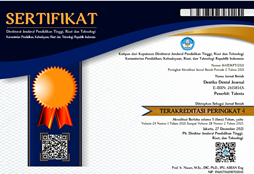Optimal Dose of 5-Fluorouracil in Inducing Oral Mucositis in Rats
DOI:
https://doi.org/10.32734/dentika.v27i2.17715Keywords:
Oral Mucositis, 5-Fluorouracil, Chemotherapeutic Agent, Optimal DoseAbstract
Oral mucositis is a side effect of chemotherapy, characterized by deep ulceration that causes white spots in the mouth. This research aimed to determine the optimal dose of 5-Fluorouracil in causing oral mucositis in rats by injecting a single dose intraperitoneally (IP) with and without chemical stimulus. The research design was a post-test control group with 24 male Wistar rats divided into eight groups. Six groups were injected with 5-Fluorouracil without chemical stimulus at a dose of 200 mg/kg, 175 mg/kg, 150 mg/kg, 125 mg/kg, 75 mg/kg, and 70 mg/kg. Meanwhile, two groups were given chemical stimulus with a dose of 5-fluorouracil 100 mg/kg (D0: 60 mg/kg, D2: 40 mg/kg), and 60 mg/kg. Observation was carried out for 21 days by paying attention to the appearance of oral mucositis and how long the rats survived. The results showed that rats injected with 5-Fluorouracil at a dose of 175 mg/kg, 150 mg/kg, 125 mg/kg, 75 mg/kg, and 70 mg/kg died before 21 days without the appearance of oral mucositis. Furthermore, rats injected with a dose of 100 mg/kg survived until an average of 13.34 days and oral mucositis appeared on day 7. Rats injected with a dose of 60 mg/kg survived more than 21 days with oral mucositis appearing on day 5. In conclusion, the optimal dose to cause oral mucositis in rats was 60 mg/kg and added a chemical stimulus in the form of 50% acetic acid.
Downloads


















